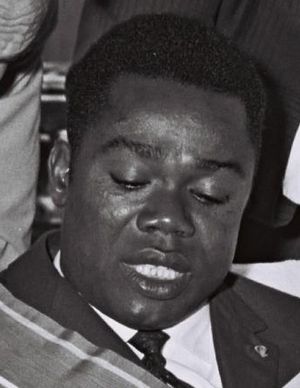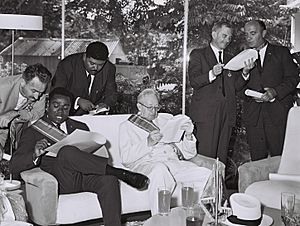David Dacko facts for kids
Quick facts for kids
David Dacko
|
|
|---|---|

Dacko in 1962
|
|
| 1st and 3rd President of the Central African Republic | |
| In office 14 August 1960 – 1 January 1966 |
|
| Preceded by | Post created |
| Succeeded by | Jean-Bédel Bokassa |
| In office 20 September 1979 – 1 September 1981 |
|
| Vice President | Henri Maïdou |
| Preceded by | Bokassa I |
| Succeeded by | André Kolingba |
| Prime Minister of the Central African Republic |
|
| In office 1 May 1959 – 14 August 1960 |
|
| Preceded by | Abel Goumba |
| Succeeded by | Post abolished |
| Personal details | |
| Born | 1927 Bouchia, Mbaiki, Ubangi-Shari (now the present-day Central African Republic) |
| Died | 21 November 2003 (aged 75–76) Yaoundé, Cameroon |
| Political party |
|
| Relations | Jean-Bédel Bokassa (cousin) |
David Dacko (1927 – 21 November 2003) was an important politician from the Central African Republic. He served as the first president of his country from 1960 to 1966. Later, he became president again from 1979 to 1981.
After being removed from power a second time, he continued to be active in politics. He was a leader in the opposition and ran for president several times. Dacko was a key political figure in the Central African Republic for more than 50 years.
Contents
Early Life and Education
David Dacko was born in 1927 in a village called Bouchia. This village was near Mbaïki in a region that was then part of French Equatorial Africa. His parents, Joseph Iniabodé and Marie Okolania, belonged to the same ethnic group, the M'Baka. He was a distant cousin of Jean-Bédel Bokassa, who would later become a rival.
When Dacko was young, his family moved to Boda. His father worked at a store there. In 1937, his father became Catholic. The next year, David went to live with his uncle in Mbaïki.
He started primary school in Mbaïki and continued in Bambari. Later, he went to a special school in Moyen Congo to become a teacher. In 1951, he became the head teacher of a large primary school in the capital city, Bangui.
In 1955, Dacko became the principal of Kouanga College. He supported Barthélémy Boganda, a leader who wanted independence for the country. Boganda was also from the Ngbaka ethnic group, like Dacko.
Political Career
Starting in Politics
In March 1957, David Dacko ran for elections in Ubangi-Shari. He won a seat in the "Territorial Assembly of Ubangi-Shari." That same year, a government council was formed. Boganda made Dacko the Minister of Agriculture, Livestock, Water, and Forests. He held this job from May 1957 to August 1958.
After that, Dacko became the Minister of the Interior and Administrative Affairs. This was from August to December 1958. When the Territorial Assembly became the Legislative Constitutive Assembly, Dacko remained in the government. He was the Minister of the Interior, Economy, and Commerce.
On March 29, 1959, Boganda died in a plane crash. The party needed a new leader. Abel Goumba wanted the job, but some party members had doubts about him. Dacko said a group of Assembly members convinced him to run. He was elected president with 39 votes, while Goumba received 11 votes.
First Time as President

The Central African Republic became independent on August 13, 1960. Dacko then became the temporary president. With help from France, he became the first official President of the Central African Republic. This was on December 12, 1960. He served until December 31, 1965. In 1960, he also led a conference for prime ministers in Equatorial Africa.
Dacko quickly worked to make his power stronger after becoming president. He also kept the job of Minister of Defense. He changed the country's rules to make it a one-party state. This meant only one political party was allowed. The president would be elected for seven years. In 1964, Dacko was re-elected in an election where he was the only candidate.
During his first time as president, Dacko greatly increased diamond production. He ended the special rights that only a few companies had for mining. He allowed any Central African person to dig for diamonds. He also helped build a factory in Bangui to cut diamonds. Diamonds became the country's most important export. Even today, they are very important, though some diamonds are taken out of the country illegally.
Dacko wanted to quickly put Central Africans in charge of the government. This led to some problems with how the government was run. The number of government workers grew a lot. This meant a large part of the country's money was used to pay salaries. It has been hard for the country to get enough money to pay many government workers ever since.
Dacko felt pulled between needing France's support and wanting to show he was independent. To show his independence, he became closer with the People's Republic of China. By 1965, many Central Africans no longer supported Dacko. He may have been planning to leave the presidency when he was removed from power.
Removed by Bokassa
On the night of December 31, 1965, and January 1, 1966, General Bokassa took over the government. This was a sudden change in leadership. Dacko, who was Bokassa's cousin, was put in prison. Later, he was kept at home under watch. He was released in 1969. In 1976, Bokassa made Dacko his personal advisor.
In the late 1970s, many people were unhappy with Bokassa's rule. Dacko managed to go to Paris, France. There, the French government convinced him to help plan a way to remove Bokassa from power. They wanted Dacko to become president again.
Back in Power
On the night of September 20-21, 1979, French soldiers helped remove Bokassa from power. This operation brought Dacko back as president. In March 1981, Dacko was elected president again in an election with several candidates. His new term began on April 1.
When Dacko returned, he had to keep many officials who had worked for Bokassa. This was because the country did not have many trained people for government jobs. Keeping these officials made some people even more unhappy with Dacko. France quickly gave Dacko's government $17 million. This helped for the first six months. However, other countries still saw Dacko as being controlled by France.
With France's help, the European Economic Community gave $20 million in aid. This money was meant to help farming, especially coffee, and to improve roads and buildings. Many Central Africans saw Dacko as a puppet of the French. His right to rule was questioned, especially by Ange-Félix Patassé. Patassé was very popular because he belonged to the country's largest ethnic group.
Patassé's supporters included high school students and young unemployed adults. Their opposition was stopped with French support by November 1979. Sometimes, Dacko's government could not pay salaries on time. This caused more unhappiness among teachers, students, and city residents. There were strikes and attacks on Dacko's officials. Police sometimes responded to these protests.
French aid helped make sure salaries were paid on time. Dacko also offered more scholarships for students. This helped reduce some of the opposition. His government also held public court cases for some of Bokassa's officials. These trials were broadcast on the radio. This made Dacko more popular, even though some people in the cities were still unsure.
Removed by Kolingba
On September 1, 1981, Dacko was removed from power again. This time, it was a change in government without fighting. The army chief of staff, General André Kolingba, led it. Some people thought French security officers might have helped Kolingba without official permission from their government. Kolingba later had a very close relationship with France.
Dacko was not harmed. He later returned to politics to lead a party called the Movement for Democracy and Development (MDD). This party was against Kolingba. Dacko ran for president in 1992 and 1993. In 1993, he received 20.10% of the votes.
Opposition, Illness and Death
During Ange-Félix Patassé's time as president (1993–2003), Dacko continued to be active in politics. He was a leader of the opposition. Dacko and Kolingba were the main opposition leaders. Kolingba had more influence than Dacko. Dacko ran for president one last time in the 1999 elections. He came in third place with 11.2% of the votes.
After General François Bozizé took over from Patassé, Dacko took part in a "National Dialogue" in September 2003. However, on September 27, Dacko became very ill with asthma and heart disease. He went to France for treatment. During a stop in Yaoundé, Cameroon, on November 7, he was taken to the hospital. He passed away on November 20, 2003.
The Central African government announced a month of national mourning for him. On December 13, he was buried in Mokinda, near his home.
Family and Awards
David Dacko was married to Brigitte. They had seven sons and four daughters. He received many awards during his life. These included Commander of the Central African Order of Agriculture and Commander of the Central African Order of Academic Palms. A major street in the country is named after him, Avenue President David Dacko.
See also
 In Spanish: David Dacko para niños
In Spanish: David Dacko para niños

